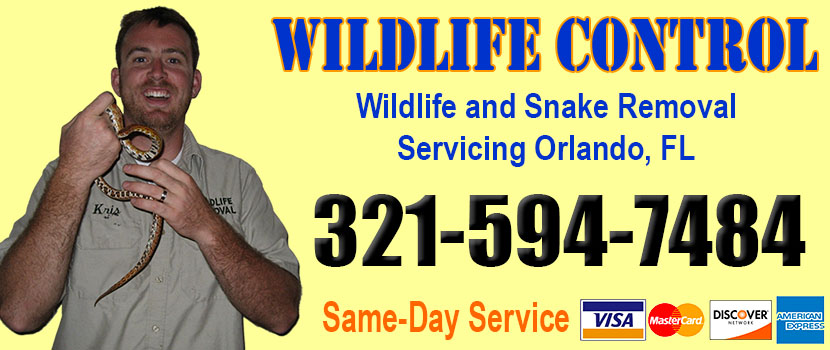
Welcome to orlandosnakes.com! I am David, a snake enthusiast living in Orlando, FL. Many people don't know that Orlando is in fact full of snakes! You just need to know where to find them - they can often be shy and elusive. Some Florida snake species are more common outside of the city limits, in different parts of Orange County FL, but many types of snakes are indeed common in the more urban parts of Orlando. This guide is meant to help educate you about the beautiful snakes of Orlando, and to help you identify the most common snakes of Orlando, as well as the venomous snakes of Orlando that you should learn to recognize and avoid. If you want more detail, click here for my complete list of ALL snake species in Orlando. Remember the following:
- Most snakes of Orlando are harmless and don't want to encounter you
- Venomous snakes exist but are uncommon in Orlando, Florida
- Snakes eat rats and mice and are a valuable part of the Florida ecosystem
- Never kill a snake - if you leave a snake alone, it will leave you alone.
Common Snake Species in Orlando
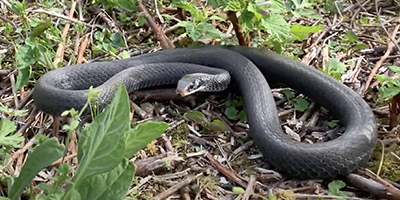 Black Racer Snake:
Orlando Florida is home to many species of snakes, but black racer snakes are in abundance in this part of the country. With an average size of 51 to 142cm, these non-venomous snakes are easy to come by in Florida if you spend time around your garden or lawn often. To identify this snake, take a look at the body of the snake. This snake usually has a white chin with brown or red blotches all over its body.
Black Racer Snake:
Orlando Florida is home to many species of snakes, but black racer snakes are in abundance in this part of the country. With an average size of 51 to 142cm, these non-venomous snakes are easy to come by in Florida if you spend time around your garden or lawn often. To identify this snake, take a look at the body of the snake. This snake usually has a white chin with brown or red blotches all over its body.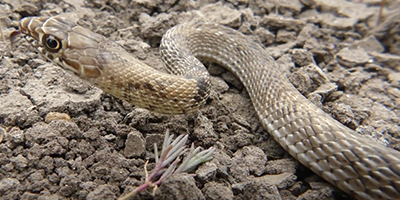 Coachwhip Snake:
This particular species of snakes is one of the largest you can ever encounter in Orlando Florida. A mature coachwhip snake can grow as long as 50 to 72 inches depending on the nature of the habitat the snake is found in. Coachwhip snakes are easy to identify. Their necks and heads are usually dark in color and it fades posteriorly to tan. Also, they are one of the few snakes in Orlando Florida with smooth skin.
Coachwhip Snake:
This particular species of snakes is one of the largest you can ever encounter in Orlando Florida. A mature coachwhip snake can grow as long as 50 to 72 inches depending on the nature of the habitat the snake is found in. Coachwhip snakes are easy to identify. Their necks and heads are usually dark in color and it fades posteriorly to tan. Also, they are one of the few snakes in Orlando Florida with smooth skin. 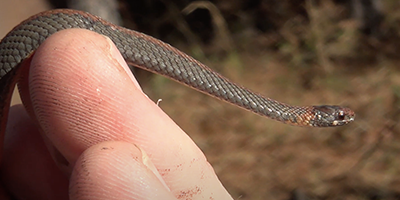 Florida Redbelly Snake:
In Orlando Florida, you will come across a Florida redbelly snake at one point or another. These snakes are known to be able to grow to a length of 16 inches, but their average length is usually within 8 to 10 inches.
Florida redbelly snakes are very similar to the ring-necked snakes being that they have a distinctive red-colored belly and a ring pattern around their neck. The only distinguishing feature that separates these two is the presence of a brown stripe down the back of the Florida redbelly snake.
Florida Redbelly Snake:
In Orlando Florida, you will come across a Florida redbelly snake at one point or another. These snakes are known to be able to grow to a length of 16 inches, but their average length is usually within 8 to 10 inches.
Florida redbelly snakes are very similar to the ring-necked snakes being that they have a distinctive red-colored belly and a ring pattern around their neck. The only distinguishing feature that separates these two is the presence of a brown stripe down the back of the Florida redbelly snake.
Venomous Snake Species in Orlando
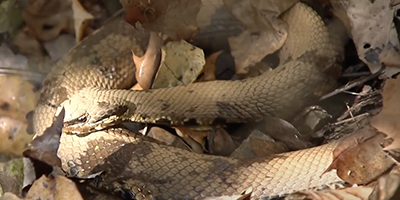 Cottonmouth:
When it comes to venomous snakes in Orlando Florida, the cottonmouth moccasin snake is at the top of the list. The good news about this snake is that they are easy to identify. The color pattern on the body of this snake varies from black to olive-brown, with or without the presence of dark crossbands along its body.
Cottonmouth moccasin snakes are pit vipers that lack rattles at the end of their tail. The absence of this makes many people confuse them with other harmless snakes. Nevertheless, these snakes are shy reptiles and will often pull back when disturbed. But if this continues, the snake might open its mouth wide showing its white inner mouth that makes it look very fearful.
Cottonmouth:
When it comes to venomous snakes in Orlando Florida, the cottonmouth moccasin snake is at the top of the list. The good news about this snake is that they are easy to identify. The color pattern on the body of this snake varies from black to olive-brown, with or without the presence of dark crossbands along its body.
Cottonmouth moccasin snakes are pit vipers that lack rattles at the end of their tail. The absence of this makes many people confuse them with other harmless snakes. Nevertheless, these snakes are shy reptiles and will often pull back when disturbed. But if this continues, the snake might open its mouth wide showing its white inner mouth that makes it look very fearful.
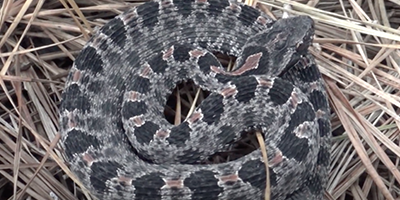 Pygmy Rattlesnake:
This small and slender snake is one of the few snakes that makes a buzzing sound that is similar to that of insects that can be heard from a mile away. These snakes are grey and prominently marked with dusky and round spots on their back. Another distinctive feature is the presence of reddish spots that alternate on the body starting from the head to the midline of the snake.
The pygmy rattlesnake is one of the few snakes in Orlando Florida that give birth to their young ones alive. If you reside in Orlando Florida, you need to be careful when moving around ponds, marshes, and lakes.
Pygmy Rattlesnake:
This small and slender snake is one of the few snakes that makes a buzzing sound that is similar to that of insects that can be heard from a mile away. These snakes are grey and prominently marked with dusky and round spots on their back. Another distinctive feature is the presence of reddish spots that alternate on the body starting from the head to the midline of the snake.
The pygmy rattlesnake is one of the few snakes in Orlando Florida that give birth to their young ones alive. If you reside in Orlando Florida, you need to be careful when moving around ponds, marshes, and lakes.
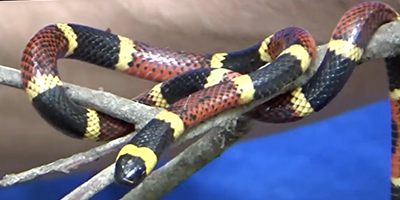 Coral Snake:
These shy and secretive snakes are some of the most poisonous snakes in Orlando Florida. Though when they are disturbed, they can be very aggressive and can cause severe damages to anyone with just a single bite. Many people often confuse this deadly snake with the harmless scarlet king snake. To identify, take a look at the head which is usually narrow in shape. Coral snakes are usually within the length of 24 inches.
Coral Snake:
These shy and secretive snakes are some of the most poisonous snakes in Orlando Florida. Though when they are disturbed, they can be very aggressive and can cause severe damages to anyone with just a single bite. Many people often confuse this deadly snake with the harmless scarlet king snake. To identify, take a look at the head which is usually narrow in shape. Coral snakes are usually within the length of 24 inches.
If you're unsure, you can email me a photo of the snake at info@orlandosnakes.com and I will email you back with the snake's species. If you found a snake skin, read my Found a Skin? page, and you can email me a photo of the skin, and I'll identify the snake for you. If you need professional Orlando snake removal help, click my Get Help page, or see the below website sponsor I found, who provides that service.
Understanding The Pigmy Rattlesnake: Appearance, Biology, Life Cycle, Habitat, Diet, Behavior
About the Pigmy Rattlesnake
A potentially dangerous snake, the pigmy rattlesnake is not one to mess with. It can cause some serious damage, though not enough to put you or others at risk. It is dangerous enough, however, for you to want to keep your distance. It is still a rattlesnake, after all, and will have its venom. A bite from one of these snakes is certainly going to come with pain and discomfort. Know how to identify these snakes and learn more about them. Both to keep you safe and to understand them in general. If you live near these snakes, learning about them is crucial for your own safety.
Appearance
As you can tell by the name, the pigmy rattlesnake is not going to get very large. Typically, they do not exceed a couple of feet. They are tiny snakes. As for the coloring, the depends entirely on the area. Pigmy rattlesnakes will have a different appearance depending on its environment. It can vary in color and patches, making it harder to distinguish individually.
Life
Like most snakes, this one has a spring mating season. When spring comes around, they come together and find a mate, impregnating the females. The females remain pregnant for several months. After a few months, they give birth to live snakes. They incubate the eggs inside of them, similarly to many others.
Behavior
Small as it may be, it is an aggressive snake. Any perceived threat may be met with a bite – and that is the likely outcome. If you go near one of these snakes and attempt to approach it, or get too close to it on accident, it may bite. It is a venomous snake so you will want to take action immediately if this occurs. Seek out professional medical care for help. It is not a deadly snake, but a venomous bite is still a venomous bite.
Habitat
Underground or in a marsh, you can find this snake in a few different types of environments. The common ground in all of these environments is the desire to go underground and stay in shelter. It will use burrows or trees, typically, to achieve this.
Diet As a small snake, it seeks out small prey. Small rodents, lizards, frogs, and similar prey are all common targets. A small snake, the pigmy rattlesnake can have a big impact. Its aggressive nature and bite may not be enough to kill, but it is still bad. Know what to look for and keep your distance if in their presence.
Remember, the term is not poisonous snakes of Orlando, it's venomous snakes of Orlando. Poison is generally something you eat, and venom is injected into you. That said, dangerous snakes are very rare in Orlando. The few venomous snakes of Orange County are rarely seen. But they are commonly misidentified, so learn about all the snake species of Orlando in order to correctly identify them. These snakes are usually also found in the surrounding towns of Orlando, Winter Garden, Apopka, Winter Park, Ocoee, Windermere, Maitland, Oakland, Lake Buena Vista, Pine Hills, Doctor Phillips, Eatonville, Alafaya, Belle Isle, Hunters Creek, Meadow Woods, Gotha, Bithlo, Bay Hill, Conway, Pine Castle, Azalea Park, Zellwood, Christmas, Wedgefield, Lake Butler, Oak Ridge, Edgewood, Orlovista, Union Park, Lockhart, Holden Heights, Southchase, Paradi and the surrounding areas.
Read our article about:
How Do Snakes Smell
orlandosnakes.com domain and hosting costs made possible by the generous support of this sponsor:
